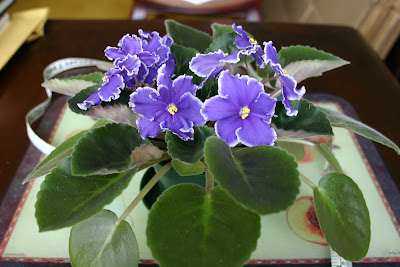I love Amaryllis.
I know, I know, they are big, blowsy, unsubtle flowers, but I still love them. I love them because they are so big and they really cheer you up when the nights are long, and flowers are but a memory of warmer days when you don’t have to put on your coat and boots to leave the house.
The Amaryllis that is commonly grown as an indoor flowering plant is actually a Hippeastrum – a member of the Amaryllidaceae family - a large genus of ornamental bulbs which are native to South and Central America and the Caribbean. Strictly speaking, Amaryllis refers to a smaller genus of flowering bulbs from South Africa, which grow outside in the ground. Things got very mixed up and now "Amaryllis" has become the common name for the Hippeastrum – and the common name for the Amaryllis is “Belladonna Lilly” or “Naked Lady”. It’s all very confusing, and we may have to have a lesson in taxonomy, but that’s for another day.
 |
| South African Amaryllis growing in California (Thanks to Wikipedia) |
The two flowers share very common attributes though. They both are flowering ornamental bulbs (which means don’t eat them) and the flower (or flowers - as there is often between 2 and 15 flowers on a stem) usually appears first on a long stem (spike, or scape), followed by the leaves once the flower has died. (As a fascinating aside, the Dutch growers produce Hippeastrum where the flower spike preceeds the leaves, and the South African growers produce Hippeastrum where the leaves coincide with the flower spike production - a wonderful clue as to the bulb’s provenance). The leaves then fuel the bulb to make next year’s blooms. The flower spike can be very long (as much as 3 feet) and sometimes the flowers are so heavy the spike will keel over. I’m sure you’ve seen Hippeastrum that need a good staking. You can see where the common name “Naked Lady” came from. I have a very good gardening friend who likens them to strippers on a pole. I can see what she means, especially if you don’t grow something else in the pot with them to disguise their nakedness.
I love buying the huge, heavy bulbs in the Fall. If you are lucky, you will get what you think you bought, but often you get a surprise. Even from the boxed sets that come complete with pot and soil. Most people who buy them this way don’t really care what they get, or even know if it’s the wrong variety. How did I know that the beautiful white Hippestrum that my son bought me for my birthday wasn’t "Apple Blossom"?
 |
| "Apple Blossom". One of my favorite varieties and one of the few Hippestrum that is scented. |
Well the first clue was "Apple Blossom" is a lovely subtle pink and secondly, "Apple Blossom" is scented, (it is one of the few that actually produce a scent) and this one was neither pink nor scented (I think it was "Picotee", so I've included a picture).
 |
| Picotee |
And this year? I bought 2 Hippeastrum from the Montreal Botanical Gardens in October. They were not varieties that I was familiar with. The first variety was named "Gervase" and the second "Black Pearl". The labels were tied to the bulbs. Just in time for Christmas, the first of the 2 bloomed. And what a surprise, it was neither "Gervase" nor "Black Pearl", but "Monaco".
 |
| "Monaco". White and pale green throat forms a star in the centre of a red bloom. Stamens are also red. No Scent |
I’m not displeased though. It’s a really beautiful bloom. The second Hippestrum has just poked its flower-head out and I’m waiting with bated breath to see what this one will be. I'll let you know.
Note: Thanks to a very, very good Wikipedia article which taught me the difference between Amaryllis and Hippestrum.















